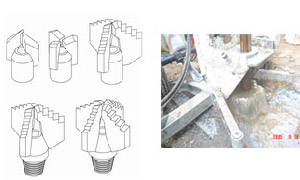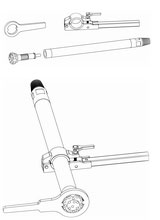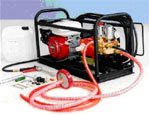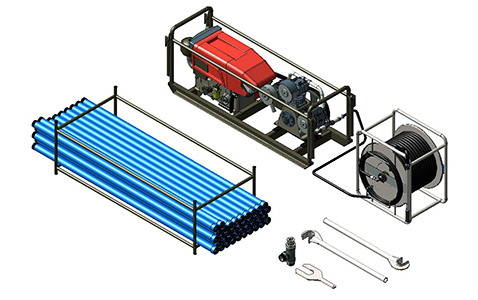How to buy a drilling rig - from PAT
What a customer needs to think about when choosing the right PAT Machine ? Pat specialise in the manufacture of drilling machines but essentially supply a complete package of accessories to work with the drilling machine – such as mud pumps, air compressors, drill pipe, drill bits – and all the other tools required through to the full completion of construction.
These brief notes are a general briefing & reminder of the technical issues involved. PAT are always ready to help customers chose the right package of equipment – and are willing & able to respond to technical issues by E mail. Prospective customers are requested to write a description of the sort of construction programme being contemplated to allow PAT to respond with a full recommendation
The Borehole Type.
This is the essential first step – define the borehole design – will the borehole be lined with casing & screen to what likely depths. To understand this you will need to know the geology the borehole will be constructed in and the occurrence of water both what depth it is located and what depth it will rest below the surface. The primary essential consideration is to have a design that houses the selected pump and then a inflow or screen section that will complement the pumps capacity. Also check out comments made lower about choice of well lining materials.The borehole diameter and depth.
Leading on from the borehole design will be an assessment of the average depth with contingency for a maximum depth, a diameter of borehole to be drilled and in what sort of geology. PAT drilling machines construct holes with the following main drill methods.Mud Drilling
This is used in sedimentary formation such as sands, gravels, clays and very soft or lightly cemented or weathered rocks. It uses a circulation of water from mud pits into a mud pump and through the drill pipe is wash to surface the drilled rock material – the fluid in the hole also hydraulically supports the borehole walls from collapse until casing is inserted. The normal drill bit used is a drag blade and these are manufactured by PAT in a huge variety of diameters – sized to drill inside casing and outside – ie to make a hole big enough to insert casing. Once a drag blade finds the rock too hard to penetrate then the ground is better drilled with ancompressor and down the hole hammer.

Compressed air drilling.
This is used in hard consolidated rock – ground that is free standing and will not collapse easily. With this method compressed air is blown down the centre of the drill pipe and the air column in the drilled hole blows drilled material to the surface. If the rock is soft enough to be cut with a drag blade type drill bit this is a quick drilling method – as soon as the penetration rate slows a down the hole hammer is used this is a percussive drilling tool that drives a piston onto a percussive rock drilling bit to pulverize the very hardest of rock. A drilling compressor is carefully selected to provide enough air volume to clean the hole and operate the down the hole hammer

Foam drilling
When drilling with compressed air a water injection pump can be used to help the drilling action – lifting material from the hole – these are built into all PAT wheeled machines – supplied as separate units on 301 Skid machine.

Important Note. Whatever drilling method is suitable all equipment is sized for the diameter of the hole being drilled – this sizing relates to the cross sectional area of the hole – the larger the area the larger the mud pump or compressor flow needs to be. Given that a 4” 100mm diameter hole is 25% the area of an 8” 200mm hole – this makes a very significant difference to the size and cost of the ancillary equipment
Mobilisation of equipment.
To be effective a drilling machine needs to be able to access the drill site easily without time delay and high expense – however equal consideration needs to be given to carriage all the other essential items required to complete the borehole construction. Note- If Mud Drilling a typical hole might require 3 – 10,000 litres of water hauled to drill site (or piped from a convenient source)
- When drilling with Down the hole hammer – most compressor units outweigh the PAT drilling machine they complement.
- Well casing, screen, gravel pack and well apron construction materials all have to be efficiently hauled to site.
Borehole completion.
Mud Drilled holes need careful development after well screen is placed – the most convenient method is compressed air – but a small volume development compressor will achieve this job – without having to deploy a machine with capacity to air drill on its own.
Once a hole is completed it is good practice to undertake a nominal test pump in part to clean the water to drinking quality and part to determine the possible flow rate and pumping level for a permanent pump installation. PAT make integrate sets of equipment to do this work.

Economics.
There are many ways of applying cost effectiveness rules to the purchase of drilling equipment each purchaser will have different criteria to arrive at the correct package to purchase.- By restricting the construction equipment package weight to a minimum can result in the most effective per bore hole in both performance time and drilling cost. Like the horse mounted cavalry soldiers of old – light, mobile and fast. Purchasing an equipment set too heavy adds to costs throughout it operation from mobilisation to storage
- All PAT equipment is designed and built for an arduous life on site – and would generally be expected to work its first 12 -24months without a huge maintenance cost. The simple basis of choice is the drilling depth and diameter to be drilled – the larger the machine the greater weight of drill pipe it can carry in a hole and the deeper it can drill – the larger the machine the more powerful the rotation and the total mass so it is easier to put weight on the drill pipe.
- When drilling rock – the dominant requirement is compressed air – the more air that is available in both volume and pressure the faster the drilling will be resulting in the lowest cost per metre – provided production can be constant – ie numerous holes lined up to be drilled one after the other.
(By accessing and using this website, you acknowledge and accept that the use of the website is at your own risk. PAT will accept no liability whatsoever for any loss arising directly or indirectly form the use of, or reliance on, any information contained on the website.)
